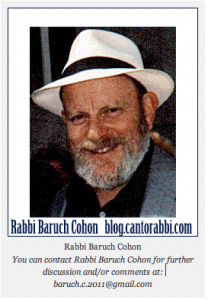DIFFERENT KINDS OF SERVICE – “Naso” – Num.4:21-7, by Rabbi Baruch Cohon
Last week’s census counted 11 tribes of Israel, numbering men age 20 and over, “all who go out to the army.” This week we find Moses counting the one remaining tribe, Levi. Here the rules are different. Each male one month old and above was already counted, and none of them go to military service at any age. What they do is religious service: carrying the Tabernacle’s posts and curtains, the altar, the ark and all the rest of the furnishings. They also are the ones who will assist the Cohanim – Aaron’s priestly family – in conducting the sacrificial ritual. And here they get counted from the age when they enter their service at 30 years old, and they will serve until the age of 50, unlike the other tribesmen who go to the army at 20 and have no upper age limit on their service.
Different rules like these bring up some logical questions. What did the Levite men do for the first 30 years of their lives? And did they “retire” to some resort at age 50? Understandably, Tabernacle service – and Temple service later – required the strongest, most alert and most productive years of their lives. So we may well assume that some serious training had to prepare them for that service. In the desert, where moving the camp called for some heavy lifting, did they spend a good part of their youth on body building? Did they go in for musical training to qualify for the Levitic choir and orchestra? And generations later, once Solomon’s Temple became their home, did they go in for Torah scholarship so they could guide their people on proper ritual conduct?
Surprisingly, the Torah does not answer these questions. Commentaries ignore them too. What the commentators do call to our attention is the specifics of the work of the three Levitic families – Gershon, Kehat and Merari. They got basically equal work to do. In fact, we learn important lessons from their tasks. For example, carrying the Torah, in the Ark of the Covenant, is not a job reserved for the eldest, Gershon, but for the more humble Kehat. No special privilege here. The lesson is clear: the Torah does not belong to any individual; it is the heritage of all Israel.
Presumably, then, whatever the men of Levi did to prepare for their sacred service, whatever training occupied their first 30 years, was the same for all of them. Most likely, the youngsters followed their fathers and learned whatever skills their fathers could teach them. Out of all their years of growth and training, the essential lesson they could learn was the unique importance of their work. For 20 years of their lives, they would enable all Israel to “walk in the light of G-d.”
Remembering that the Israelite camp moved through the desert for – not 20 but – 40 years, we can figure that the men of Levi had ample time to perfect their service. And finally to cross the Jordan into the Promised Land, carrying the sacred symbols of the faith. Their strength, their skill, their dedication set the pace to inspire the descendants of slaves to become a nation.
Today those Jews whose Hebrew names include the word “ha-Levi” don’t have to carry any synagogues. But if their firstborn is a son, he does not require a “Pidyon haBen” redemption ceremony, because the ancient tribe of Levi was symbolically given to G-d to replace the firstborn of all the other tribes, after the Tenth Plague killed the firstborn of Egypt and spared Israel. And when the Torah is read in services, the Levi is entitled to the second “Aliyah,” to pronounce the blessing. And he does not have to wait until he’s 30 years old either. 13 will do just fine.
So we don’t have a full description of the young Levites’ preparation years. But their descendants, and all of us, can savor their history of service.



Thank you for this week’s interpretation. My mother was a Levite, and my father was a Yisrael. He always told me that God loved the Yisraels the best so he made so many more of them.. Shabbat Shalom and Hag Shavu’ot Sameach next week.